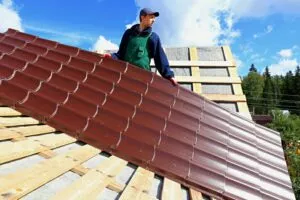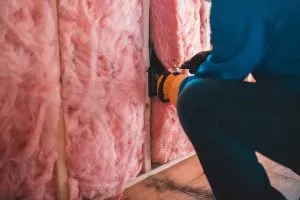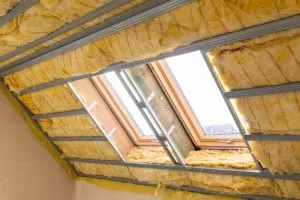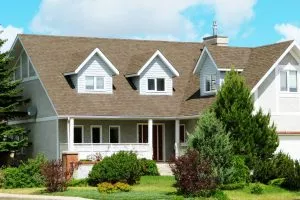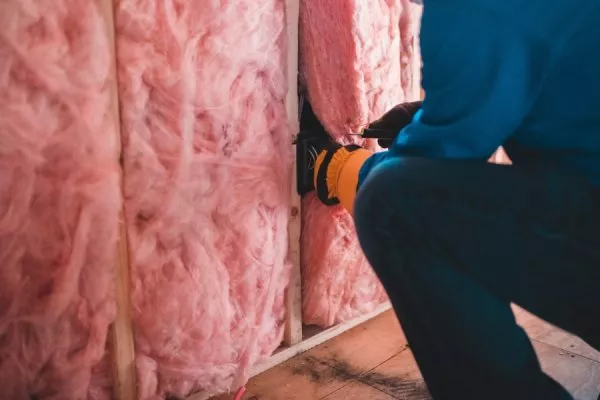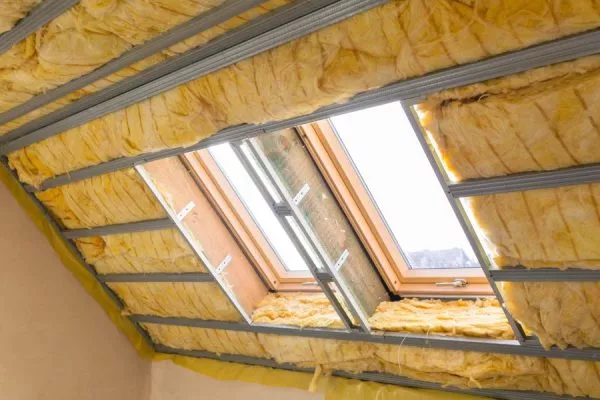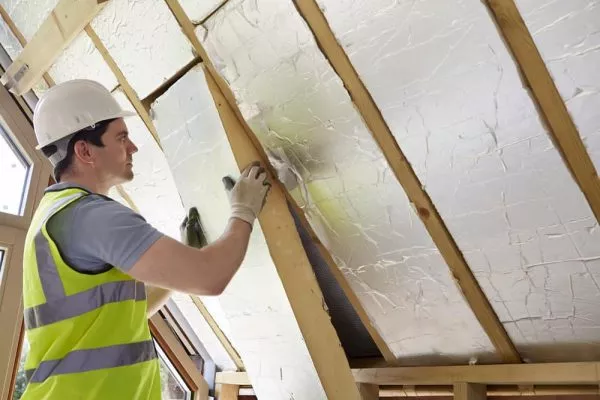Attic insulation is essential for improving the lifespan of your roof. It works by maintaining a stable temperature in the attic, which reduces stress on the roofing materials and prevents damage from expansion, contraction, and moisture buildup.
But the benefits of attic insulation go beyond just extending the life of your roof. It also plays a significant role in energy efficiency, helping you save on heating and cooling costs by keeping indoor temperatures consistent. Proper insulation controls moisture levels in the attic, preventing condensation that can lead to mold growth and wood rot.
Here are some key advantages of investing in quality attic insulation:
- Prolonged roof lifespan through temperature regulation
- Reduced risk of moisture-related damage
- Lower energy bills due to improved thermal performance
Understanding these benefits will help you see why investing in quality attic insulation is a smart move for protecting your home’s roof and saving on energy costs.
Factors Affecting Your Roof’s Lifespan and Common Challenges
Several factors can influence how long your roof lasts:
- Temperature Fluctuations: Rapid changes in temperature can put stress on roofing materials, leading to wear and tear over time.
- Moisture Buildup: Excessive moisture can seep into the structure of the roof, causing damage and reducing its longevity.
- Thermal Expansion and Contraction: The constant expanding and contracting of roofing materials due to temperature changes can weaken the roof’s integrity.
Common Challenges That Can Impact Your Roof’s Lifespan
Here are some common challenges that may affect how long your roof lasts:
- Ice Dams: Poor insulation can lead to ice dams forming on the roof, causing water to seep under shingles and potentially damage the structure.
- Shingle Warping: Inadequate temperature regulation in the attic can result in shingles warping or cracking, compromising the roof’s protection.
How Attic Insulation Extends Roof Lifespan
Attic Insulation helps with temperature regulation in attic spaces, which directly impacts the durability of roofing materials. By maintaining a more consistent temperature, insulation reduces the thermal stress caused by extreme heat and cold cycles. This thermal stress leads to expansion and contraction of shingles and other roofing components, accelerating wear and tear.
Benefits of attic insulation for roof lifespan include:
- Temperature Regulation: Proper insulation prevents excessive heat buildup in summer and heat loss in winter. This balance helps avoid shingle warping, cracking, or premature aging caused by temperature extremes.
- Moisture Control: Insulation works together with ventilation to minimize condensation inside the attic. Excess moisture can lead to mold growth and wood rot under the roof deck, weakening structural integrity.
- Preventing Roof Damage with Insulation: By controlling humidity levels, attic insulation stops water vapor from accumulating on cold surfaces, which is a leading cause of ice dams and moisture-related damage.
Reducing both thermal fluctuations and moisture buildup creates a healthier environment for roofing materials to perform optimally over time. This protection extends your roof’s lifespan while preserving its effectiveness against environmental elements.
Types of Attic Insulation Materials for Roof Health
Choosing the right attic insulation material affects your roof’s durability and moisture control. Common types include:
1. Fiberglass Insulation
Fiberglass batt insulation is widely used due to its affordability and ease of installation. It resists heat transfer effectively, helping regulate attic temperature. However, it can absorb moisture if exposed to leaks, which reduces its insulating properties and may promote mold growth.
2. Spray Foam Insulation
Spray foam insulation provides superior air sealing by expanding to fill gaps and cracks. This creates a tight barrier against air leaks and moisture intrusion, enhancing roof lifespan by maintaining a stable attic environment. Its durability is excellent, but cost tends to be higher than other options.
3. Blown-In Cellulose Insulation
Made from recycled paper treated for fire resistance, cellulose insulation offers good thermal performance and is eco-friendly. It fits well around irregular spaces in attics but can settle over time, potentially creating gaps if not properly maintained. Moisture resistance depends on installation quality and attic ventilation.
Best Practices for Installing Attic Insulation to Maximize Roof Longevity
Proper insulation installation is critical for protecting your roof and extending its lifespan. You need to focus on even and gap-free installation to prevent air leaks and thermal bridging. Air leaks allow warm or cold air to escape, causing uneven temperatures that stress roofing materials. Thermal bridging occurs when gaps in insulation let heat pass through structural elements, leading to localized temperature fluctuations that can warp shingles or cause moisture buildup.
Professional installation importance cannot be overstated. Experienced installers know how to achieve gapless installation, ensuring all spaces are fully insulated while maintaining attic ventilation pathways.
Attic ventilation is another factor in controlling moisture levels. Without sufficient airflow, moisture from household activities condenses in the attic, promoting mold growth and wood rot under the roof deck. Proper ventilation balances air intake (soffit vents) with exhaust (ridge or gable vents), reducing humidity and preventing condensation damage that compromises roof durability.
Together, professional installation and correct ventilation form a powerful combination that protects your roof from thermal stress and moisture-related issues—two of the biggest threats shortening roof lifespan.
Maintenance Tips for Insulated Roofs to Prolong Lifespan
Proper maintenance is essential for ensuring the longevity of your insulated roof. By following these maintenance tips, you can prevent moisture buildup and protect your insulation from damage.
1. Conduct Regular Roof Inspections
Regular roof inspections are crucial for identifying any potential issues before they worsen. Here are some inspection strategies to consider:
- Inspect your insulated attic at least twice a year, preferably in spring and fall.
- Look for any signs of water stains, mold growth, or musty odors, which may indicate moisture intrusion.
- Check the insulation material for any signs of compression or damage.
- Check all vents and exhaust fans are functioning properly to allow for adequate airflow.
2. Clean Gutters and Remove Debris
Clogged gutters and debris accumulation can lead to trapped moisture, which can degrade insulation over time. Here’s how you can maintain your gutters:
- Clean your gutters at least twice a year, or more frequently if you have overhanging trees.
- Remove any leaves, twigs, or other debris that may be blocking the flow of water.
- Check that downspouts are directing water away from the foundation of your home.
Considering Additional Energy-Efficient Roofing Solutions Complementing Insulation
Energy-efficient roofing solutions enhance the performance of attic insulation by addressing heat management at the roof surface. Cool roofs stand out for their ability to reflect sunlight and reduce heat absorption. This reflection lowers roof surface temperatures, decreasing thermal stress on roofing materials and lessening heat transfer into the attic space.
Benefits of Cool Roofs
Cool roofs offer several advantages:
- Sunlight Reflection: Special coatings or materials reflect a significant portion of solar radiation.
- Reduced Heat Build-up: Lower surface temperatures prevent overheating of shingles and roofing membranes.
- Energy Savings: Less heat entering the attic means your HVAC system works less, cutting cooling costs.
Pairing attic insulation with cool roofs creates a synergy that optimizes thermal regulation in your home. While insulation slows down heat exchange between the attic and living spaces, cool roofs minimize the initial heat load on the roof itself. This combination:
- Reduces temperature fluctuations inside the attic.
- Limits expansion and contraction cycles that can damage roofing materials.
- Enhances moisture control by preventing excessive attic warmth that drives condensation.
Other energy-efficient roofing options, like green roofs, also complement insulation by providing natural insulation layers and managing stormwater, further protecting roof structures.
Benefits Beyond Longevity
Attic insulation reduces energy costs by directly improving your HVAC system’s efficiency. When your attic is properly insulated, it minimizes unwanted heat transfer between the living space and the outside environment. This means your heating and cooling systems don’t have to work as hard to maintain comfortable indoor temperatures.
Key advantages include:
- Lower energy bills: Reduced strain on HVAC equipment leads to decreased electricity or fuel consumption.
- Longer HVAC lifespan: Less wear and tear on your system translates into fewer repairs and replacements over time.
- Consistent temperature regulation: Insulation helps maintain an even temperature throughout your home, eliminating hot or cold spots.
Beyond financial savings, attic insulation enhances indoor comfort year-round. You experience:
- More stable indoor climates regardless of seasonal extremes.
- Improved protection against drafts and fluctuating temperatures.
- A quieter home environment, since insulation also dampens external noise.
Investing in effective attic insulation is a smart strategy to extend roof lifespan with insulation by regulating temperature and protecting roof from moisture damage. You gain multiple benefits. Proper insulation is not just about immediate comfort or savings—it safeguards your roof’s structural integrity for years to come, making it a worthwhile long-term investment.
FAQs
How does attic insulation improve the lifespan of my roof?
Attic insulation regulates temperature fluctuations in the attic, reducing thermal stress on roofing materials. It also controls moisture by preventing condensation, which helps avoid mold growth and wood rot under the roof deck, ultimately extending the roof’s durability and lifespan.
What are the common challenges that affect roof lifespan and how can insulation help?
Common challenges include temperature fluctuations causing thermal expansion and contraction, moisture buildup leading to mold and wood rot, and issues like ice dams and shingle warping. Proper attic insulation helps mitigate these problems by maintaining stable attic temperatures and controlling moisture levels.
What types of attic insulation materials are best for enhancing roof health?
Common attic insulation materials include fiberglass batt, spray foam, and blown-in cellulose. Each has pros and cons regarding durability and moisture resistance. Choosing the right type depends on your specific needs for roof protection, energy efficiency, and moisture control.
Why is proper installation of attic insulation important for maximizing roof longevity?
Proper installation ensures even, gap-free coverage that prevents air leaks and thermal bridging. This maintains effective temperature regulation and moisture control in the attic. Adequate attic ventilation complements insulation by controlling moisture levels, which together protect the roof from damage.
What maintenance tips should I follow to prolong the lifespan of an insulated roof?
Regularly inspect your insulated attic for early signs of damage or moisture intrusion. Keep gutters clean and free from debris to prevent trapped moisture that can degrade insulation. Consistent maintenance helps sustain insulation effectiveness and protects your roof from premature deterioration.
How does combining attic insulation with other energy-efficient roofing solutions benefit my home?
Combining attic insulation with solutions like cool roofs—which reflect sunlight to reduce heat absorption—maximizes overall energy savings. This synergy improves HVAC efficiency, reduces energy costs, enhances indoor comfort through stable temperature regulation, and increases home value while extending roof lifespan.



